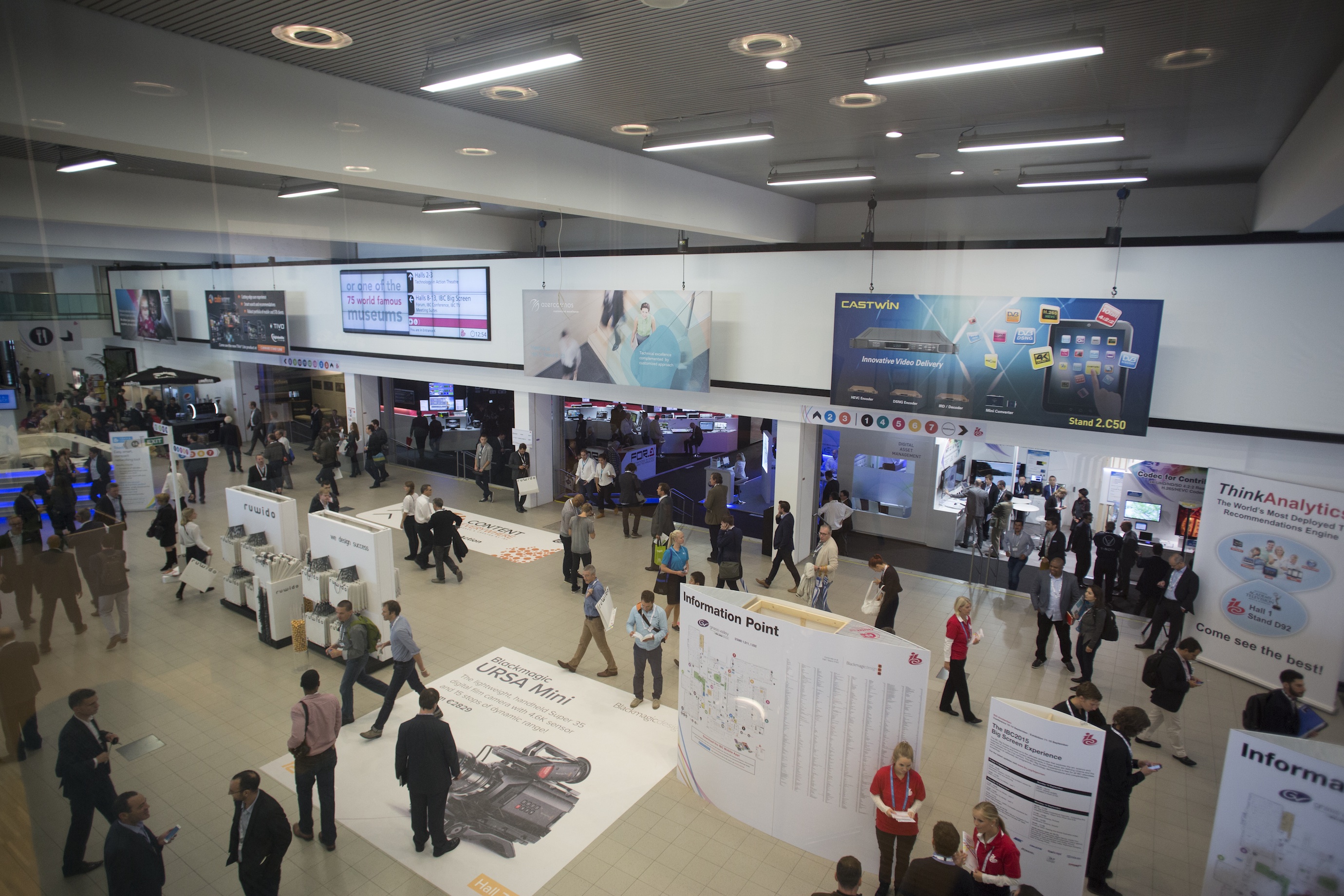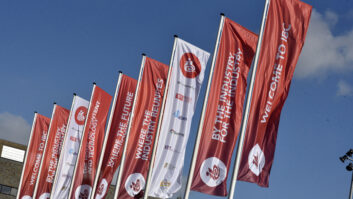
Paddy Baker reports from the Amsterdam show that’s increasingly outgrowing its traditional broadcast roots.
As we’re frequently remarking in Installation, the worlds of broadcast and AV are moving ever closer to each other. Content creators are increasingly looking to break out of the regime of the broadcast schedule and are seeking other means of reaching audiences; while converging technologies – and falling prices – are bringing broadcast-quality content within the reach of ever-smaller enterprises. With this in mind, we set off to the Amsterdam RAI last month looking to see various product groups that would appeal to the Installation readership – and we weren’t disappointed.
Intercom
RTS launched its first OMNEO-based keypanel – the KP-Series. These are targeted at a wide range of intercom applications, including theatres, sports venues and houses of worship. Design assistance from the Electro-Voice speaker engineering R&D group has led to superior sound quality, says RTS.
Ergonomically designed four-way levers providing talk/listen and volume allow for single-handed operation. A full range of external connections for GP-I/O and ancillary audio functions are now offered as standard.
Three models are available: the KP-5032 2RU keypanel with 32 operation keys;
the KP-4016 1RU model keypanel with 16 keys and the EKP-4016 1RUextension panel, also with 16 keys. Each keypanel features a full-colour HD display, and can display Latin, Cyrillic, or simplified Chinese characters.
The keypanels feature both backward compatibility with existing RTS analogue matrices and forward compatibility thanks to the OMNEO open IP architecture (which is built on the Dante transmission protocol) and OCA (Open Control Architecture).
Clear-Com launched the 2.4GHz version of FreeSpeak II at IBC 2015. This extends the usability of the wireless intercom system to countries where the 1.9GHz band is licensed; but as the two versions can be used on the same system, it enables systems that are at their maximum number of users at 1.9GHz to be extended. When using the base station, up to 20 full-duplex wireless beltpacks using either or both 1.9GHz and 2.4GHz bands can be connected. The new version offers identical capabilities to the 1.9GHz version, and can also be integrated with Clear-Com’s Eclipse HX matrix system, which enables as many as 50 1.9GHz and 40 2.4GHz full-duplex wireless beltpacks to be used at the same time.
Also on show from Clear-Com was LQ-R, an addition to the LQ Series of IP interfaces. These link or extend industry-standard 2-wire or 4-wire intercoms and audio systems to remote locations over LAN, WAN or IP networks. They can operate in either point-to-point or partyline modes.
LQ-R provides either four or eight ports per rack unit, with the options of either eight 4-wire connections, four 2-wire connections, or four 2-wire and four 4-wire connections in a single unit. A maximum of six LQ IP interfaces can be linked together in any 2- or 4-wire combination.
Lectrosonics showed the smallest full-featured UHF bodypack microphone transmitter available today – the SSM (Super Slight Micro). A member of the company’s Digital Hybrid Wireless Series, the SSM is fully compatible with all current Lectrosonics receivers including the UCR411A, SR, L and Venue Series, along with several older models via compatibility modes. The SSM features a wide tuning bandwidth of up to about 76MHz depending on the specific frequency range, or three standard Lectrosonics blocks.
An infrared sync port on the SSM allows for quick set-up with compatible receiver systems, and a backlit LCD allows for setup in dim lighting conditions. Future firmware updates can be added via a micro-B USB port.
IP, streaming, recording
One of the companies that has led the migration of broadcast technology into the AV space, Blackmagic Design was once again out in force at IBC. “AV is becoming a more prominent part of our business year on year,” commented senior communications manager EMEA Patrick Hussey, highlighting shopping centres and cruise ships among growing markets for the company. The stand featured a demonstration of the company’s video over IP technology – again, something of growing interest in both the AV and the broadcast spaces.
Among the company’s technology launches were three Teranex Mini video converter models: these enable to convert from 12G-SDI to Quad SDI, from Quad SDI to 12G-SDI, and to distribute a single SDI source to eight SDI outputs.
Exterity demonstrated its new range ‘Beyond the LAN’ range of products, which enable TV and video to be streamed to a variety of devices over WAN, WiFi, the internet or via a content delivery network. The combination of Exterity’s AvediaStream transcoders and its Origin Server enables organisations to make video content consistently available across their HQ and regional offices.
The company also demonstrated its embedded HDCPv2 technology, which enables it to legitimately encode and stream directly from an HDMI video source, keeping content secure across an IP network from source to display.
Making its debut on the Matrox Video stand were the Matrox Monarch HDX Dev Tools, which enable system integrators to harness the streaming and recording capabilities of Monarch HDX H.264 encoding equipment. Using the HTTP-based Monarch HDX Control API, developers can create their own control software to start and stop encoding, set bitrates and destinations, and get the status of a Monarch HDX device. By loading an XML configuration file or instructing the device to retrieve configuration information from a URL at boot-up, all Monarch HDX encoding and destination parameters can be set automatically.
Teracue eyevis launched the ENC-400 H.264 fanless video encoder and recorder, which is designed for both broadcast and webcast use. Its dual-channel H.264 encoding and recording engine can deliver multiple streams in multiple bitrates and protocols to multiple destinations. The build-in frame synchroniser is said to guarantee stable signal processing. The encoder consumes less than 5W and can be powered from a USB port.
Distributor 3D Storm was showing the brand new LiveMedia Server, the latest addition to the LiveXpert range of tools. Suitable for use at exhibitions and events, it is a multichannel and multiformat player and recorder.
The system supports a large range of audio and video codecs, in both SD and HD, with built-in up/down conversion and aspect ratio adjustment.
Thanks to LiveMedia Server’s ‘Play While Rec’ function, users can add a file to any playout channel while the file is still being recorded.
Two models are available: a dual-channel version in a 1RU unit and a four-channel in 4RU. Selection of inputs and outputs is flexible, allowing any channel to be configured for recording or playout.
KVM
IHSE launched the high-speed Draco tera KVM matrix switch, which features expanded bandwidth to enable real-time switching of large amounts of data, including 4K60 video signals. It is available in a variety of sizes, the biggest of which contains 576 I/O ports – believed to be the biggest in the industry for KVM, and twice the capacity of its predecessor – which can be configured for Cat5e/6, fibre or a combination.
There is redundancy in almost every component, apart from the backplane – so boards can be hotswapped. The switch is compatible with the full range of IHSE interface cards.
In a deal worth an estimated $500,000, the company announced the sale of the first 576-port Draco tera KVM switch at the show.
Also on show at the IHSE stand was the Draco 4K ultra DP extender, which uses the LICI codec, developed in conjunction with Fraunhofer IIS. It can be used in point-to-point configurations or in conjunction with a matrix switch.
KVM manufacturer Guntermann & Drunck showed its matrix grid, which facilitates working across locations. This new function allows several KVM matrix systems to be interconnected and communicate bidirectionally – regardless of the topology of the individual systems. The result is that any connected console can access any connected computer even across locations and at distances of up to 10km over fibre connections.
Also on show was G+D’s I/O-Card-Multi, which broadens the range of signal types that can be supported by the company’s ControlCenter-Digital to include, for instance, SDI, MADI and Ethernet. Independent devices can be connected and their signals switched and transmitted transparently, together with KVM signals.
Audio
HHB presented the European debut of the Roland O.H.R.C.A M-5000C digital mixing. This offers all the flexibility and power of the M-5000 console in a smaller footprint, delivering 128 freely definable audio paths, expandable protocols and multi-format I/O choices combined with a flexible user interface and workflow, all with 24-bit / 96kHz sound quality.
Also making its debut was the Roland V-1200HD 2 M/E video switcher. This features a new hybrid engine that combines a 4:2:2 / 2 M/E switcher with a 4:4:4/10-bit multi-format processor presentation switcher.
AKG was showing the MicroLite series of miniature wearable reference microphones, aimed at theatre and conference applications as well as broadcast. These are said to offer incredible sound quality and durability in a tiny, discreet form factor, and are available in includes lavalier, ear-hook and headworn options. Broad compatibility, excellent moisture resistance and superior EMC protection are also stated benefits of the MicroLite range. They complement AKG wireless systems such as the DMS800, and can be easily integrated with products from other Harman brands.
Riedel took out an advertisement above one of the main entrances to the Rai with a perplexing message – it simply read “no news”. It turned out that the company was simply making a virtue of the fact that it was not holding a major press launch this year. There were new product announcements, however, including an AES67 card, which extends the connectivity of Riedel Artist digital matrix intercom systems. The card, which will be available next year, installs into the Artist mainframe and can then be configured through the Director software.







